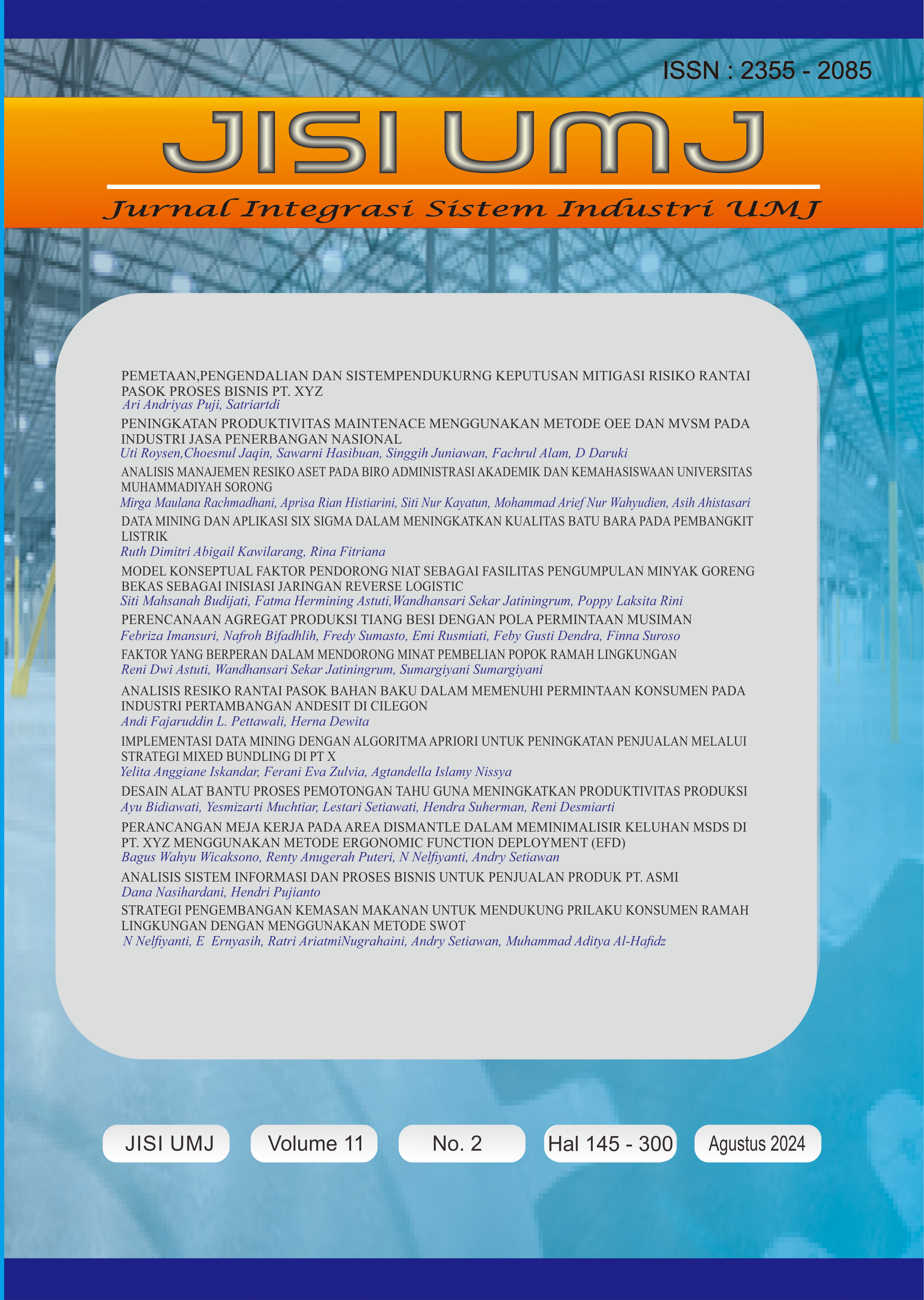FAKTOR YANG BERPERAN DALAM MENDORONG MINAT PEMBELIAN POPOK RAMAH LINGKUNGAN
DOI:
https://doi.org/10.24853/jisi.11.2.213-226Abstract
Diantara produk yang banyak dikonsumsi masyarakat yang berpotensi besar merusak lingkungan adalah popok sekali pakai karena komposisi bahan yang sulit terurai di alam seperti plastik dan Super Absorbent Polimer (SAP). Popok kain ini dianggap lebih ramah lingkungan. Hanya saja jumlah pengguna popok sekali pakai tetap lebih banyak, khususnya di daerah berkembang seperti Kabupaten Bantul. Untuk itu dilakukan penelitian yang bertujuan untuk mengetahui faktor yang berpengaruh terhadap niat penggunaan popok ramah lingkungan ini. Faktor yang diteliti adalah: sikap terhadap penggunaan green product, norma subyektif, perceived behavioral control, kepedulian terhadap lingkungan, perceived risk, dan personal norm. Pengolahan data dielakukan dengan regresi berganda. Dari hasil penelitian diperoleh fungsi regresi: Niat= 0,058sikap + 0,284SN + 0,390PBC + 0,032KL – 0,026PR + 0,118Norm. Berdasarkan uji t didapat kesimpulan bahwa faktor yang signifikan berpengaruh adalah perceived behavioral control, norma subyektif, dan personal norm.References
Ajzen, I. (1991). The Theory of Planned Behavior. Organizational Behavior and Human Decision Process, 50(2), 179–211.
Astuti, R. D., & Jatiningrum, W. S. (2023). The Determinant Factors of Intention to Use Cloth Diapers in The Yogyakarta Area Faktor Determinan Intensi Penggunaan Popok Kain di Kota Yogyakarta. 16(1), 148–157.
Barbarossa, C., & De Pelsmacker, P. (2016). Positive and Negative Antecedents of Purchasing Eco-friendly Products: A Comparison Between Green and Non-green Consumers. Journal of Business Ethics, 134(2), 229–247. https://doi.org/10.1007/s10551-014-2425-z
Chen, M. F., & Tung, P. J. (2014). Developing an extended Theory of Planned Behavior model to predict consumers’ intention to visit green hotels. International Journal of Hospitality Management, 36, 221–230. https://doi.org/10.1016/j.ijhm.2013.09.006
Costa, C. S. R., Costa, M. F. da, Maciel, R. G., Aguiar, E. C., &
Wanderley, L. O. (2021). Consumer antecedents towards green product purchase intentions. Journal of Cleaner Production, 313(June). https://doi.org/10.1016/j.jclepro.2021.127964
Darma, B. (2021). Statistika Penelitian Menggunakan SPSS (Uji Validitas, Uji Reliabilitas, Regresi Linier Sederhana, Regresi Linier Berganda, Uji t, Uji F, R2). Guepedia.
Dewi, S. A., & Rastini, N. M. (2016). Peran Green Trust Memediasi Green Perceived Value Dan Intention. E-Journal Manajemen Unud, 5(12), 8046–8078.
Diyah, I. A., & Wijaya, T. (2017). Determinant Factors of Purchase Intention on Green Product. Jurnal Aplikasi Manajemen, 15(1), 54–62. https://doi.org/10.18202/jam23026332.15.1.07
Ferdiansyah, Y., & Pratomo, L. A. (2023). Analysis of the Influence of Consumer Purchase Intentions on Green Product Purchase. Jurnal Ekonomi Trisakti, 3(2), 2561–2576. https://doi.org/10.25105/jet.v3i2.17410
Gansser, O. A., & Reich, C. S. (2023). Influence of the new ecological paradigm (NEP) and environmental concerns on pro-environmental behavioral intention based on the theory of planned behavior (TPB). Journal of Cleaner Production, 382, 134629.
Ghozali, I. (2011). Aplikasi Analisis Multivariat dengan Program IBM SPSS 19. Universitas Diponegoro.
Giarti, P., & Santoso, H. (2015). Analisis Faktor Yang Mempengaruhi Intensi Pembelian Hijau Pada Green Cosmetic. Industrial Engineering Online Journal, 4(1). https://ejournal3.undip.ac.id/index.php/ieoj/article/view/7939
Hadi, A., Rusli, B., & Alexandri, M. B. (2019). Dampak Undang-Undang Nomor 12 Tentang Pangan Terhadap Ketahanan Pangan Indonesia. Responsive, 2(4), 173–181. https://doi.org/10.24198/responsive.v2i3.26085
Hair Jr., J., Black, W. C., Babin, B. J., & Anderson, R. (2010). Multivariate_Data_Analysis__7th_Edition_.pdf (seventh ed). Pearson Prentice Hall.
Harjadi, D., & Gunardi, A. (2022). Factors affecting eco-friendly purchase intention: subjective norms and ecological consciousness as moderators. Cogent Business and Management, 9(1). https://doi.org/10.1080/23311975.2022.2148334
Hernomo, A. F. (2021). Pengaruh Pengetahuan Lingkungan Dan Kepedulian Lingkungan Terhadap Niat Beli Produk the Body Shop Di Surabaya. Performa, 6(4), 302–311. https://doi.org/10.37715/jp.v6i4.2552
Hmielowski, J. D., Boyd, A. D., Harvey, G., & Joo, J. (2019). The social dimensions of smart meters in the United States: Demographics, privacy, and technology readiness. Energy Research and Social Science, 55(October 2018), 189–197. https://doi.org/10.1016/j.erss.2019.05.003
Hoang Yen, N. T., & Hoang, D. P. (2023). The formation of attitudes and intention towards green purchase: An analysis of internal and external mechanisms. Cogent Business and Management, 10(1). https://doi.org/10.1080/23311975.2023.2192844
Irfan, F., & Khiriyah, S. (2013). Faktor-Faktor Yang Mempengaruhi Niat Konsumen Untuk Membeli Produk Hijau (Studi pada Wanita di Kota Solo). Fokus Manajerial, 12(1), 12–22.
Jaiswal, D., & Kant, R. (2018). Green purchasing behaviour: A conceptual framework and empirical investigation of Indian consumers. Journal of Retailing and Consumer Services, 41(August 2017), 60–69. https://doi.org/10.1016/j.jretconser.2017.11.008
Kaplan, S., Gruber, J., Reinthaler, M., & Klauenberg, J. (2016). Intentions to introduce electric vehicles in the commercial sector: A model based on the theory of planned behaviour. Research in Transportation Economics, 55, 12–19. https://doi.org/10.1016/j.retrec.2016.04.006
Kementerian Lingkungan Hidup dan Kehutanan. (2023). Timbulan Sampah.
Kresno, Z., & Wahyono, W. (2019). The Influence Of Green Perceived Value, Risk And Quality Toward Green Purchase Intention Through Green Trust. Management Analysis Journal, 8(1), 79–89. https://journal.unnes.ac.id/sju/index.php/maj/article/view/30218
Lestari, R. B., & Widagdo, H. (2019). Analisis Perilaku Konsumen Sadar Lingkungan Di Palembang. Jurnal Adminika, 5(2), 16–27. http://www.journal.poltekanika.ac.id/index.php/adm/article/view/102
Mohamed, M., Higgins, C., Ferguson, M., & Kanaroglou, P. (2016). Identifying and characterizing potential electric vehicle adopters in Canada: A two-stage modelling approach. Transport Policy, 52, 100–112. https://doi.org/10.1016/j.tranpol.2016.07.006
Nia, B. P., Dyah, I. R., Hery, S., & Bayu, D. S. (2018). The Effect of Green Purchase Intention Factors on the Environmental Friendly Detergent Product (Lerak). E3S Web of Conferences, 73, 3–7. https://doi.org/10.1051/e3sconf/20187306007
Parinsa, R. A., & Halomoan, N. (2022). Kajian Timbulan Sampah Popok Sekali Pakai Di Kabupaten Karawang. Jukung (Jurnal Teknik Lingkungan), 8(1), 84–94. https://doi.org/10.20527/jukung.v8i1.12992
Prasetyo, F. D., Triasti, R. D., & Ayuningtyas, E. (2021). Pemanfaatan Limbah Popok Bayi (Diapers) Sebagai Media Tanam. Jurnal Rekayasa Lingkungan, 21(1), 41–49. https://doi.org/10.37412/jrl.v21i1.91
Putri, P. H., & Rahmiati, R. (2021). The influence of green perceived value, green perceived risk, and green trust on green repurchase intention on clodi (clothing diapers) Ningrat. Marketing Management Studies, 1(2), 85–95. https://jkmp.ppj.unp.ac.id/index.php/mms/article/view/117
Rais, Z. F. (2022). Identifikasi Timbulan dan Perencanaan Pengelolaan Limbah Bahan Berbahaya dan Beracun (B3) di TPA Piyungan. Universitas Islam Indonesia.
Ratnaningtyas, R. P. (2020). Sampah Dalam Kacamata Media Online. Jurnal Komunikasi, 12(1), 16. https://doi.org/10.24912/jk.v12i1.5287
Rezaei, R., Safa, L., Damalas, C. A., & Ganjkhanloo, M. M. (2019).
Drivers of farmers’ intention to use integrated pest management: Integrating theory of planned behavior and norm activation model. Journal of Environmental Management, 236(November 2018), 328–339. https://doi.org/10.1016/j.jenvman.2019.01.097
Ruslim, T. S., Kartika, Y., & Hapsari, C. G. (2022). Effect Of Environmental Concern, Attitude, Subjective Norms, Perceived Behavioral Control And Availability On Purchase Of Green Skincare Products With Intention To Purchase As A Mediation Variable. Jurnal Ilmiah Manajemen Dan Bisnis, 8(1), 120. https://doi.org/10.22441/jimb.v8i1.14499
Shalender, K., & Sharma, N. (2021). Using extended theory of planned behaviour (TPB) to predict adoption intention of electric vehicles in India. Environment, Development and Sustainability, 23(1), 665–681. https://doi.org/10.1007/s10668-020-00602-7
Simanjuntak, M., Nafila, N. L., Yuliati, L. N., Johan, I. R., Najib, M., & Sabri, M. F. (2023). Environmental Care Attitudes and Intention to Purchase Green Products: Impact of Environmental Knowledge, Word of Mouth, and Green Marketing. Sustainability (Switzerland), 15(6). https://doi.org/10.3390/su15065445
Skogen, K., Helland, H., & Kaltenborn, B. (2018). Concern about climate change, biodiversity loss, habitat degradation and landscape change: Embedded in different packages of environmental concern? Journal for Nature Conservation, 44, 12–20. https://doi.org/10.1016/j.jnc.2018.06.001
Wang, S., Lin, S., & Li, J. (2018). Exploring the effects of non-cognitive and emotional factors on household electricity saving behavior. Energy Policy, 115, 171–180.
Wibisono, H., Firdausi, F., & Kusuma, M. E. (2020). Municipal solid waste management in small and metropolitan cities in Indonesia: A review of Surabaya and Mojokerto. IOP Conference Series: Earth and Environmental Science, 447(1). https://doi.org/10.1088/1755-1315/447/1/012050
Wu, S.-I., & Chen, Y.-J. (2014). The Impact of Green Marketing and Perceived Innovation on Purchase Intention for Green Products. International Journal of Marketing Studies, 6(5), 81–100. https://doi.org/10.5539/ijms.v6n5p81
Xu, Y., Du, J., Khan, M. A. S., Jin, S., Altaf, M., Anwar, F., & Sharif, I. (2022). Effects of Subjective Norms and Environmental Mechanism on Green Purchase Behavior: An Extended Model of Theory of Planned Behavior. Frontiers in Environmental Science, 10(February). https://doi.org/10.3389/fenvs.2022.779629
Yue, B., Sheng, G., She, S., & Xu, J. (2020). Impact of consumer environmental responsibility on green consumption behavior in China: The role of environmental concern and price sensitivity. Sustainability (Switzerland), 12(5), 1–16. https://doi.org/10.3390/su12052074
Zhang, L., Fan, Y., Zhang, W., & Zhang, S. (2019). Extending the theory of planned behavior to explain the effects of cognitive factors across different kinds of green products [Ampliando la teoría del comportamiento planificado para explicar los efectos de los factores cognitivos en diferentes tipos de p. Sustainability (Switzerland), 11(15), 1–17.
Zhang, W., & Luo, B. (2021). Do environmental concern and perceived risk contribute to consumers’ intention toward buying remanufactured products? An empirical study from China. Clean Technologies and Environmental Policy, 23(2), 463–474. https://doi.org/10.1007/s10098-021-02061-8
Zhuang, W., Luo, X., & Riaz, M. U. (2021). On the Factors Influencing Green Purchase Intention: A Meta-Analysis Approach. Frontiers in Psychology, 12(April), 1–15. https://doi.org/10.3389/fpsyg.2021.644020
Downloads
Published
Issue
Section
License
COPYRIGHT POLICY
The author(s) of an article published in the JISI UMJ retains ownership of the intellectual property rights in work (s).
PUBLISHING RIGHTS
The author(s) of an article published in the JISI UMJ have unrestricted publication rights. The authors give the JISI UMJ the right to publish the article and designate the Industrial of Engineering Universitas Muhammadiyah Jakarta Publishing as the original publisher of the article.
LICENSING POLICY
Journal of Industrial Engineering and Sciences is an open-access journal that follows the Creative Commons Non-Commercial 4.0 International License (CC BY-NC 4.0), which states that:

Under this license, the reusers must give appropriate credit, provide a link to the license, and indicate if changes were made. Users may do so in any reasonable manner, but not in any way that suggests the licensor endorses users or their use.
Please take the time to read the whole license agreement (https://creativecommons.org/licenses/by-nc/4.0/). As long as reusers follow the license conditions, the owner cannot withdraw these freedoms. The following components are included under this license:
 Attribution: Users must provide appropriate attribution, including a link to the license, and indicate whether or not they made any modifications. Users are free to do so reasonably, but not in a manner that indicates the licensee approves of their usage.
Attribution: Users must provide appropriate attribution, including a link to the license, and indicate whether or not they made any modifications. Users are free to do so reasonably, but not in a manner that indicates the licensee approves of their usage.
 NonCommercial: Users may not use the material for commercial purposes.
NonCommercial: Users may not use the material for commercial purposes.





